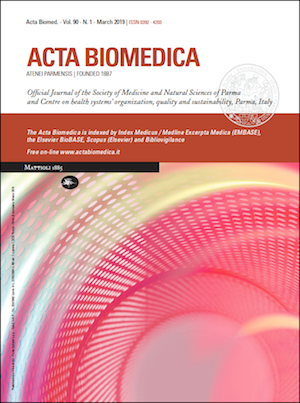Suicide in the elderly: a 37-years retrospective study
Keywords:
suicides, aged 60 and over, autopsy and police reports, suicide rates, risk factorsAbstract
Background: The rates of suicide increase with age and reach their highest levels in the oldest age groupings and are sufficiently large for them to constitute a public health concern. The number of deaths due to suicides after the age of 60 years in Italy is 1,775 (41.36%) in 2013; there is a constant increase of elder population over the last ten years and elderly are almost twice of young. It is in this context that suicide arises, a risk factor during old age. Method: This is a retrospective study of autopsy and police reports of suicide from January 1979 through December 2015. Data about suicides after the age of 60 years was collected from the Archives of the Legal Medicine of the University of Parma, a Northern Italian city. Trend and characteristics (age, sex, marital status, pathological factors and method of suicide) were assessed. Results: A total of 538 cases (394 males, 144 females) were identified. Male sex correlates to a higher suicidal risk, with a male-female ratio of 2.74:1. The highest risk of suicide is observed in the age between 70 and 79 years. Pathological factors were revealed in 427 cases (physical state for 194 cases, mental state for 233 cases); mental illness was related significantly to suicidal risk. Hanging is the most common suicide method (175 cases), followed by fall from height (130 cases), drowning (101 cases) and use of firearms (56 cases); differences regarding methods employed were detected between males and females. The choice of method sometimes is indicative of a clear decision, while other times it is strictly linked to the availability of the means. Conclusions: Suicidal behavior seems to be the product of the interaction of many factors, such as biological or psychological diseases or painful events. The presence of chronic and debilitating diseases, often accompanied by profound psychological suffering, is a powerful stimulus for suicide among men, whereas mental state is a significant risk factor for women, with the majority suffering from depression. The psychological and the biological changes, the cognitive deficits and the common diseases facilitate the structuring of depressive characteristics.
Downloads
Published
Issue
Section
License
This is an Open Access article distributed under the terms of the Creative Commons Attribution License (https://creativecommons.org/licenses/by-nc/4.0) which permits unrestricted use, distribution, and reproduction in any medium, provided the original work is properly cited.
Transfer of Copyright and Permission to Reproduce Parts of Published Papers.
Authors retain the copyright for their published work. No formal permission will be required to reproduce parts (tables or illustrations) of published papers, provided the source is quoted appropriately and reproduction has no commercial intent. Reproductions with commercial intent will require written permission and payment of royalties.







